一、学习目标
这节课是本次实训第二节课程,本次课的重点是熟练掌握gsql工具的使用。gsql是openGauss数据库提供在命令行下运行的数据库连接工具,可以通过此工具连接服务器并对其进行操作和维护,除了具备操作数据库的基本功能,gsql还提供了若干高级特性,便于用户使用。
二、课程学习
2.1 gsql命令
如果想充分的了解gsql命令及其参数具体含义,可通过gsql --help来查看。
omm@modb:~$ gsql --help gsql is the openGauss interactive terminal. Usage: gsql [OPTION]... [DBNAME [USERNAME]] General options: -c, --command=COMMAND run only single command (SQL or internal) and exit -d, --dbname=DBNAME database name to connect to (default: "omm") -f, --file=FILENAME execute commands from file, then exit -l, --list list available databases, then exit -v, --set=, --variable=NAME=VALUE set gsql variable NAME to VALUE -V, --version output version information, then exit -X, --no-gsqlrc do not read startup file (~/.gsqlrc) -1 ("one"), --single-transaction execute command file as a single transaction -?, --help show this help, then exit Input and output options: -a, --echo-all echo all input from script -e, --echo-queries echo commands sent to server -E, --echo-hidden display queries that internal commands generate -k, --with-key=KEY the key for decrypting the encrypted file -L, --log-file=FILENAME send session log to file -m, --maintenance can connect to cluster during 2-pc transaction recovery -n, --no-libedit disable enhanced command line editing (libedit) -o, --output=FILENAME send query results to file (or |pipe) -q, --quiet run quietly (no messages, only query output) -C, --enable-client-encryption enable client encryption feature -s, --single-step single-step mode (confirm each query) -S, --single-line single-line mode (end of line terminates SQL command) Output format options: -A, --no-align unaligned table output mode -F, --field-separator=STRING set field separator to zero byte -0, --record-separator-zero set record separator to zero byte -2, --pipeline use pipeline to pass the password, forbidden to use in terminal must use with -c or -f Connection options: -h, --host=HOSTNAME database server host or socket directory (default: "local socket") allow multi host IP address with comma separator in centralized cluster -p, --port=PORT database server port (default: "5432") -U, --username=USERNAME database user name (default: "omm") -W, --password=PASSWORD the password of specified database user For more information, type "\?" (for internal commands) or "\help" (for SQL set field separator (default: "|") -H, --html HTML table output mode -P, --pset=VAR[=ARG] set printing option VAR to ARG (see \pset command) -R, --record-separator=STRING set record separator (default: newline) -r if this parameter is set,use libedit -t, --tuples-only print rows only -T, --table-attr=TEXT set HTML table tag attributes (e.g., width, border) -x, --expanded turn on expanded table output -z, --field-separator-zero commands) from within gsql, or consult the gsql section in the openGauss documentation.复制
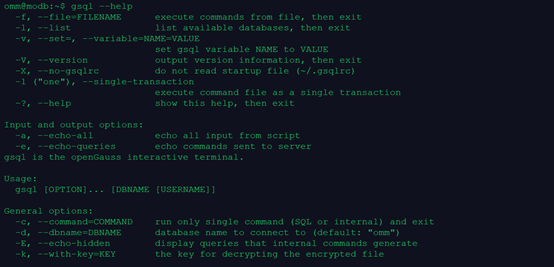
\h复制
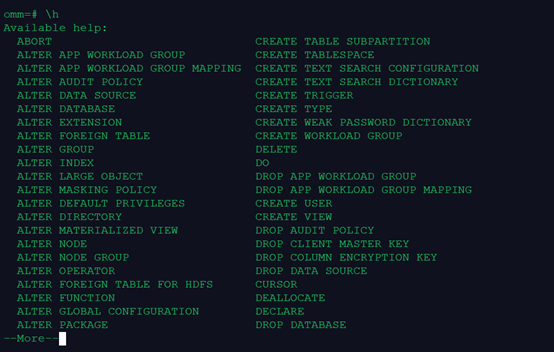
\?复制

每个命令详细解释还可以通过openGauss官网 https://docs.opengauss.org/zh/docs/3.1.0-lite/docs/Toolreference/gsql.html去查询gsql更详细的使用。
2.2 gsql查看数据库的版本
select version(); show server_version; \copyright复制

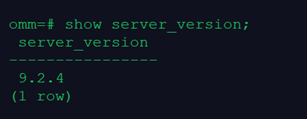
2.3 gsql命令及其含义
以下gsql常用命令及其含义,如下表:
| 元命令 | 具体含义 |
|---|---|
| \l | 列出所有可用的数据库,然后退出 |
| \conninfo | 显示会话的连接信息 |
| \c[onnect] [DBNAME] | 在gsql中,切换连接的数据库postgres |
| \du | 显示数据库集簇中目前有哪些用户和角色 |
| \dg | dg用法同du |
| \db | 显示当前数据库集簇中目前有哪些表空间 |
| \dn | 显示当前数据库有哪些数据库模式 |
| \dt | 显示当前数据库中所有的表 |
| \d TableName | 查看某个表信息 |
| \d IndexName | 查看某个索引信息 |
| \di | 显示关系列表 |
| \x | 打开扩展表格式模式 |
| \r | 提供了对gsql命令的历史版本支持 |



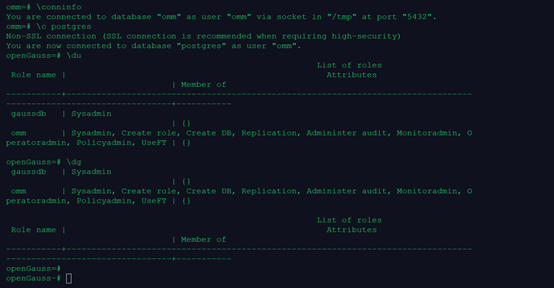

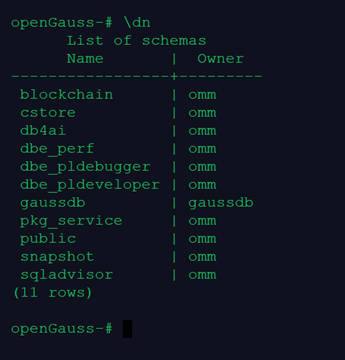
2.4 测试gsql中的默认事务自动提交功能
--查看gsql中事务是否默认为自动提交 show AUTOCOMMIT; --测试gsql中事务默认为自动提交功能 create table customer_new as select * from customer_t; \q --重新登录后看到之前创建的表customer_new: gsql -d postgres -p 5432 -r \dt复制
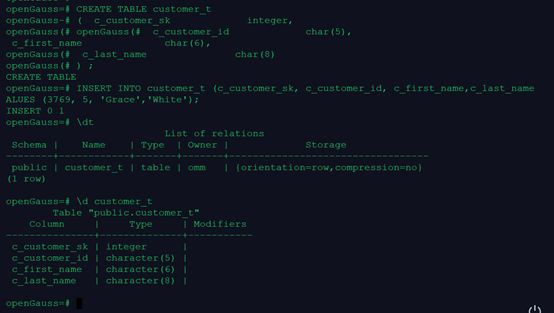
2.5 测试gsql中的事务手动提交功能
–测试gsql手动提交 #Opengauss默认执行完一条语句后,立即提交。可以关闭自动提交功能: #注意:此处设置ATUOCOMMIT必须用大写! \set AUTOCOMMIT off --插入一些数据 INSERT INTO customer_t (c_customer_sk, c_customer_id, c_first_name,c_last_name) VALUES (6885, 1, 'Joes', 'Hunter'), (4321, 2, 'Lily','Carter'), (9527, 3, 'James', 'Cook'), (9500, 4, 'Lucy', 'Baker'); --查看表中数据 select * from customer_t; --执行回滚 ROLLBACK; --检查是否回滚成功 SELECT * FROM customer_t;复制

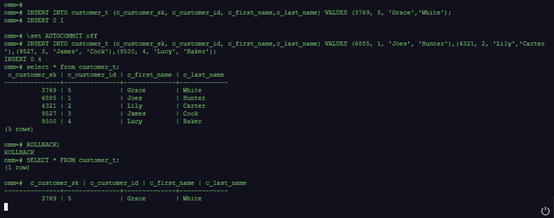
2.6使用两种方法,连到postgres数据库中
gsql -r 或 gsql -d omm -p 5432 -r复制


「喜欢这篇文章,您的关注和赞赏是给作者最好的鼓励」
关注作者
【版权声明】本文为墨天轮用户原创内容,转载时必须标注文章的来源(墨天轮),文章链接,文章作者等基本信息,否则作者和墨天轮有权追究责任。如果您发现墨天轮中有涉嫌抄袭或者侵权的内容,欢迎发送邮件至:contact@modb.pro进行举报,并提供相关证据,一经查实,墨天轮将立刻删除相关内容。
评论
目录






